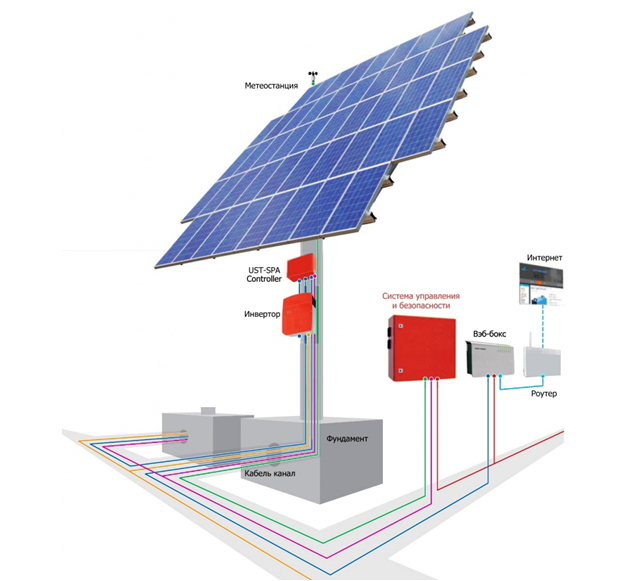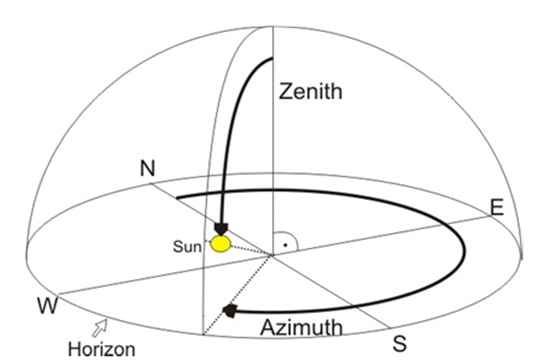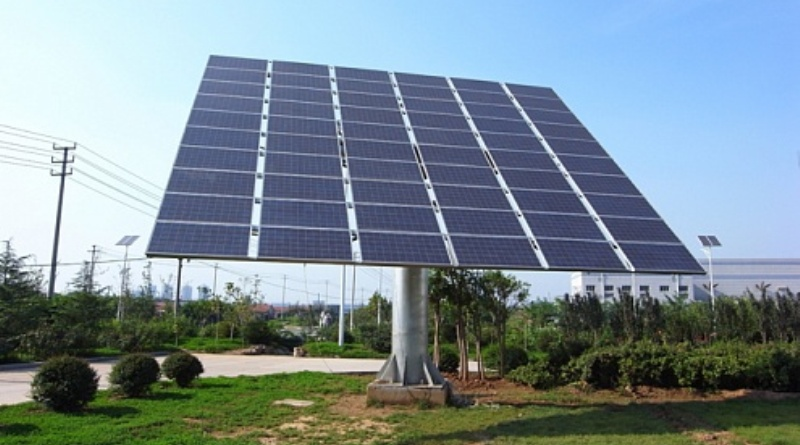Solar trackers are specialized structures whose task is to periodically change the orientation of photovoltaic panels or mirrors relative to the sun. The angle of inclination of the working surfaces is adjusted manually or automatically, which allows you to achieve the highest possible performance of solar systems of any type.
General information
The role of a radiation catcher fixed on the tracker can be:
- helio module that combines a battery of semiconductor cells;
- a parabolic mirror that focuses the rays on a receiver in the form of a heating tank or a Stirling engine;
- special optical devices – most often lenses;
- other PV, CPV, HCPV and CSP systems.
The task of the tracker for solar panels is to ensure that the angle of incidence of the rays is as close as possible to the perpendicular of 90 ° at any time.

The standard tracker for solar panels includes the following items:
- Basic structure. It consists of a fixed support and a rotary device that allows rotation in one or two planes.
- Mechanical positioning system. Controls the moving part using mechanisms called actuators.
- Integrated security system. Provides various types of protection – against lightning discharges, power surges in the network, mechanical overloads. The most expensive models have their own mini weather station. With the threat of storms, hurricanes and other dangerous weather phenomena, the system temporarily changes the angle of inclination of the working surfaces to the maximum safe position.
- Control systems. Designed for convenient management of trackers, including remote access and their maintenance.
- Navigation system. Only included with roaming units with a mobile base. Allows you to enter data on the geographic location into the control loop – longitude, latitude, altitude above sea level.
Note: the level of complexity of completing trackers depends on the tasks set for the system and economic feasibility.
Solar tracker for one solar panel – design requirements
For all types of trackers there is a mandatory requirement – high strength and stability. The main danger for structures of this kind is strong winds, which can overturn the batteries along with the support masts.
The characteristic features of large modules are significant weight and large working area, and, hence, windage. That is why the most advanced systems with weather stations on board deploy solar panels during storms in such a way that the modules are located facing the direction of the wind.
Types of solar trackers
A wide range of existing models is due to different requirements for the functionality of the system in certain conditions. These are the geographic latitude and longitude, as well as the climatic features of the installation site. It affects the choice and cost-effectiveness of using trackers. For small low-power stations, the purchase of expensive rotary units is not advisable.
Solar trackers with one axis of rotation (single axis)
The rotation of the working surfaces in such systems is performed only around one axis. The control is carried out by special software according to the SPA algorithm (Solar Position Algorithm).
Depending on the choice of the priority coordinate direction, trackers with rotation around such axes are distinguished:
- vertical – VSAT;
- horizontal – HSAT;
- oblique – TSAT;
- with orientation to the side of the world (polar) – PASAT.
1. Vertical single axis tracker (VSAT) – vertical.
This group of trackers is used mainly in high latitudes and makes the solar panels rotate from east to west. This direction of rotation requires maintaining such a distance between the elements on the supports in order to prevent partial shading of neighboring panels during rotation.
2. Horizontal single axis tracker (HSAT) – horizontal.
Horizontal solar trackers are typical for low latitudes. The rotation is oriented along the North-South line, which requires a strictly parallel placement of the mounting tubes on each panel relative to each other.
3. Tilted single axis tracke (TSAT) – inclined.
This variety rotates the work surfaces diagonally about the vertical and horizontal axes. Features of the movement also require preventing the shadow of some modules from falling on others.
4. Polar aligned single axis trackers (PASAT) – polar.
The reference point for the tracker system is the polar star. For uniaxial structures, this is considered the classic and most common. The angle of inclination of the batteries always turns out to be equal to the geographic latitude.
Solar trackers with two axes of rotation – Dual axis trackers (DAT)
Two levels of regulation allow such systems to constantly maintain the optimal position of the solar panels relative to the sun. This maximizes their productivity and, on large solar farms, justifies the financial outlay for the purchase.
1. Tip-tilt dual axis tracker (TTDAT) modification.
The basis of the rotary system is a long support with a ball bearing. The vertical axis is secondary for such a design, the main movement is in the horizontal plane. For biaxial structures, the distance between the elements must be even greater than for single-axis options.
2. Azimuth-altitude dual axis tracker (AADAT) modification .
Unlike the previous type of structures, AADAT uses not one large bearing on the support, but a ring with a platform.
The advantage of this solution is greater stability and the possibility of placing a module with a sufficiently large number of panels on one platform. The disadvantage of the design is the need to take into account the dimensions of the ring, which requires a larger area of \u200b\u200bthe site.
Mechanisms for orientation of solar panels
Movable elements of trackers can be controlled manually or automatically. The second option assumes the presence in the system of one or two actuators powered by an electric motor.

Support for the desired direction to the sun (can be issued programmatically in the form of Fig . 1 solar position algorithm – SPA), these devices are carried out as follows.
Method number 1. Use of sensors with sensitive photocells.
With optimal orientation, the radiation flux to the sensors is the same. As the sun moves, certain photocells begin to receive less light, to which the control system immediately reacts and sends a signal to the actuators to make a correction.
The advantage of such a system is in full automation and calculation of azimuth and zenith angles in real time. The disadvantage is the complete loss of performance in the absence of sufficient lighting, during heavy rain, snow or contamination of the sensor surface.
Method number 2. Manual control of actuators.
Like direct do-it-yourself panel angle adjustments, rocker-operated actuators allow for manual orientation changes, but much faster. Typically, manual correction is performed infrequently, 2-4 times a year, which is quite enough for relatively low-budget SES .
It is also possible to control trackers semi-automatically, for which a programmed timer on a logic controller is used, rather than complex software on a secure computer.
Rules for choosing trackers for solar panels
A certain type of tracker system is selected based on factors such as the climatic conditions of the area, the size of the modules, the area of the site, etc.
The best choice is:
- HSAT with a horizontal axis – for systems at low latitudes. They are relatively inexpensive, easier to operate and provide maximum performance in the second half of the day, when consumption is highest.
- A vertical axis VSAT is at high latitudes where it is more important to follow the low-lying sun from east to west.
- biaxial TTDAT and AADAT – in large-scale high-performance solar power plants, where even a slight increase in the efficiency of one panel due to the optimal direction to the sun gives a serious increase in the overall generation of the system.
